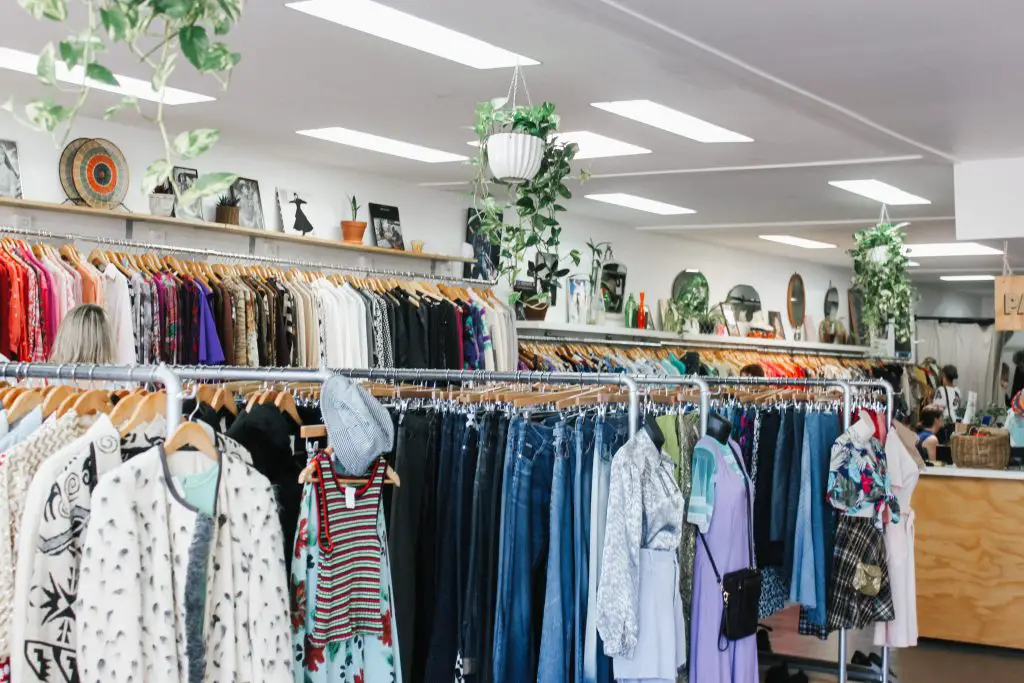Zara, H&M, GAP, Mango, TopShop, Forever 21. You probably know most, if not all, of these brands. Perhaps you even own a few items in your wardrobe. But what do these brands have in common?
- They’re fast fashion labels.
- They’re bad, for a couple of reasons.
- You should probably avoid buying from them next time you shop.
Okay, that was quite a leap and you probably have plenty of questions right now. So sit back, get your pen and paper ready, and let’s discuss.
Contents
What is Fast Fashion?

Fast fashion refers to the rapid production of cheap, mass-produced clothing items often inspired from the runway. Its beginnings can be traced to the early 1990s, when Spanish fashion brand Zara opened its first U.S. store in New York.
The brand became famous for its production model of putting out new collections every two weeks. After that, pretty much every other clothing retailer—including Abercrombie & Fitch, Primark, and J.Crew—followed suit.
From the 1990s to the early 2000s, a radical shift in the fashion industry happened. From following a seasonal calendar (or two collections a year), clothing retailers were now releasing new designs every week.
And that’s how fast fashion began and eventually became a widespread practice in the retail industry.
Fast Fashion: The Good
From a business perspective, fast fashion has its pros. For one it’s an extremely cost-efficient way of putting out clothing merch into the market while maximising profit.
By shortening the time between designing clothes and getting it on the rack, manufacturers are able to respond more quickly to changing consumer demands.
From a consumer perspective, fast fashion has its merits too. It used to be that the clothes featured in runways were only for the rich. Fast fashion has upended the clothing industry by giving consumers more choices and making clothes more affordable.
As Edology points out, “[Fast fashion] has massively benefitted consumers, transforming the market by focusing on simplicity, convenience, accessibility and affordability.”
Fast Fashion: The Bad
While fast fashion has definitely revolutionised the apparel and footwear industry, unfortunately, its drawbacks appear to overshadow its benefits. Let’s take a look at some of the criticisms thrown against fast fashion:
1. The Rise of ‘Disposable Fashion’
One of the arguments against fast fashion is how it cultivates a throwaway culture that encourages consumers to simply ‘buy, buy, buy.’
Before the fast-fashion era, people had to plan which time of the year they were going to buy clothes. Now, the surplus of cheap clothing in the market means it’s easier for people to simply buy on impulse and discard clothes that are no longer ‘on trend.’
Each year, an estimated 80 to 100 billion pieces of clothing are made and sold worldwide. However, WWF Switzerland reported that while worldwide consumption of clothes doubled between the years 2000 and 2014, consumers keep their clothing items only about half as long as they did during the same period.
2. Unsustainable Practices
Quite obviously, the rapid and unhampered production of clothing merchandise consumes vast amounts of natural resources, from raw materials for fibre to water to land resource, not to mention fossil fuel. The growing demand for clothes puts a tremendous strain on our finite planetary resources.
A good example of this is cotton production. While it is a natural renewable fibre, cotton is a very thirsty plant and requires huge amounts of water to cultivate. In Central Asia, for instance, water reserves are already drying up due to cotton farming in surrounding areas.
3. Waste and Pollution
Clothesmaking produces waste. With fast fashion, the amount of waste generated gets quadrupled. Unfortunately, so do pollution levels. Take a look at these figures:
- The fashion industry has already overtaken both the maritime and international flight industry in terms of global carbon emissions. If the fashion industry doesn’t curb its overproduction, by 2030 its greenhouse gas emissions will rise to 50%.
- Each year for the past 20 years, US garment manufacturers have created 120 million tonnes worth of textile waste. The UK has not fared better, sending 235 million items of clothing, majority of which are recyclable, to landfills.
- Twenty percent of the world’s wastewater comes from garment manufacturing.
- Dyeing fabrics is also a major contributor to wastewater production as well as water pollution.
- The use of pesticides and insecticides in cotton farms has resulted in fish kills, water pollution, and toxic dust storms in the Aral Sea.
4. Worker Exploitation
Several fast-fashion labels have time and again been accused of unethical labour practices, including poor working conditions in factories, child labour, demanding excessive overtime, and sub-poverty wages.
A 2015 documentary on the fashion industry, The True Cost, highlights the social cost of the booming clothing economy. This includes the deadly Rana Plaza collapse in Bangladesh that claimed the lives of 1,132 people and injured 2,500, most of them garment factory workers.
Another shocking fact the film presents is the large number of suicides by Indian cotton farmers (almost 250,000 since 2000), most of whom had been in heavy debt from buying genetically modified cotton seeds.
5. Intellectual Theft
There’s a thin line between intellectual theft and inspiration. Unfortunately, in the case of fast fashion, this line is blurred. Some fashion houses have accused several fast-fashion brands of straight-up copying their runway designs. Now that’s just being lazy.
Can Fast Fashion Be Sustainable?
While fast-fashion labels have in recent years stepped up their efforts to reduce their impact, these appear superficial and more of lip service.
Swedish clothing brand H&M has launched its Conscious Collection, which features sustainable and organic clothing and accessories. However, this begs the question: If H&M can release a sustainable line of clothing, why can’t they just shift their entire supply chain toward that end?
Other brands are also offering ‘take back’ programmes, which allow consumers to return used or unwanted clothing in exchange for coupons or store credits. However, in reality, only 0.1 percent of these garments are recycled.
The bottom line is, the fashion industry, most especially its big-time players, needs a radical shift if it ever intends to undo or mitigate the damage the fast-fashion model has done. However, to do that would entail sacrificing profit, so that may seem like a tall order.
Taking Back the Fashion Industry

This is not to say that changing the fashion landscape is impossible. In recent years, the slow fashion movement has become increasingly popular; proof of this is the ever-growing list of slow-fashion labels that value quality over quantity and people and the environment over unbridled profit.
We, as consumers, also have a major part to play in making change happen. Here are just some things we can start practicing today:
- Support slow-fashion labels. You don’t necessarily have to buy from them. Liking and following them on social media and spreading the word is already a big help.
- Don’t buy into trends. Shift your preferences to timeless, quality clothing pieces that last longer and will outlast the changing trends and seasons.
- Be a conscious and informed buyer. Do your research and ask questions before buying from any retailer.
- Adopt a minimalist mind-set. Take an inventory of the clothes and footwear you have. You may be surprised to find out you actually have more than enough and that you don’t need to buy any more.
- Buy second-hand. Buying brand-new, whether from slow or fast-fashion brands, still consumes resources. Go for what’s already available. Shop from consignment stores, thrift shops, or have a look at charity shops and yard sales.
- Don’t throw away your clothes. Reuse, repair, donate, or recycle clothing you already own.
Fashion is all about choices. And the choices we make today will largely influence whether the fashion industry will shape up or continue on the same track.
With enough of us making better fashion choices, we can surely create a large enough impact in the way the fashion industry operates in the world.
Other Articles That May Interest You:
The Slow Fashion Movement: What It Is, and Why We Should All Get Behind It
Capsule Wardrobe: A Sustainable Closet That Never Goes Out of Style
8 Best Dress Rental Sites for the Eco-friendly and Frugal Fashionista
Sustainably Dress for Less: 5 Online Thrift Stores Worth Checking Out
11 Sustainable & Ethical Jewellery Brands to Up Your Style Game
Eco-friendly Makeup Brands That Are Great for Your Skin (and the Planet!)



Leave a Reply